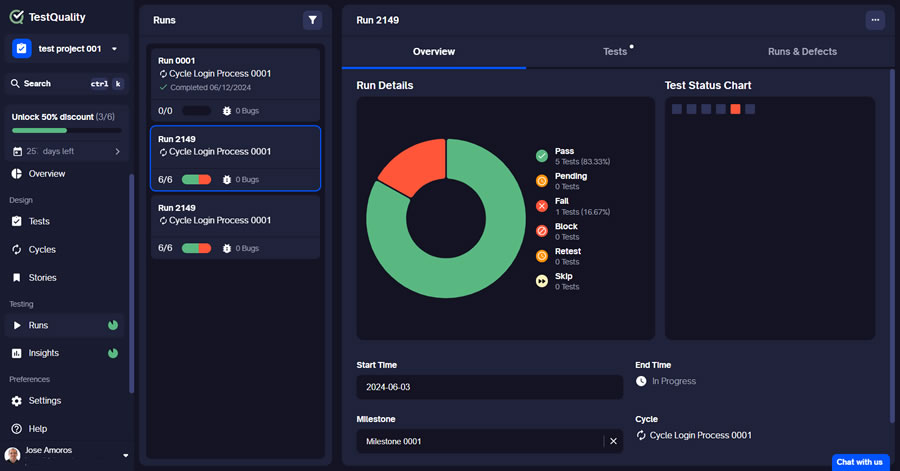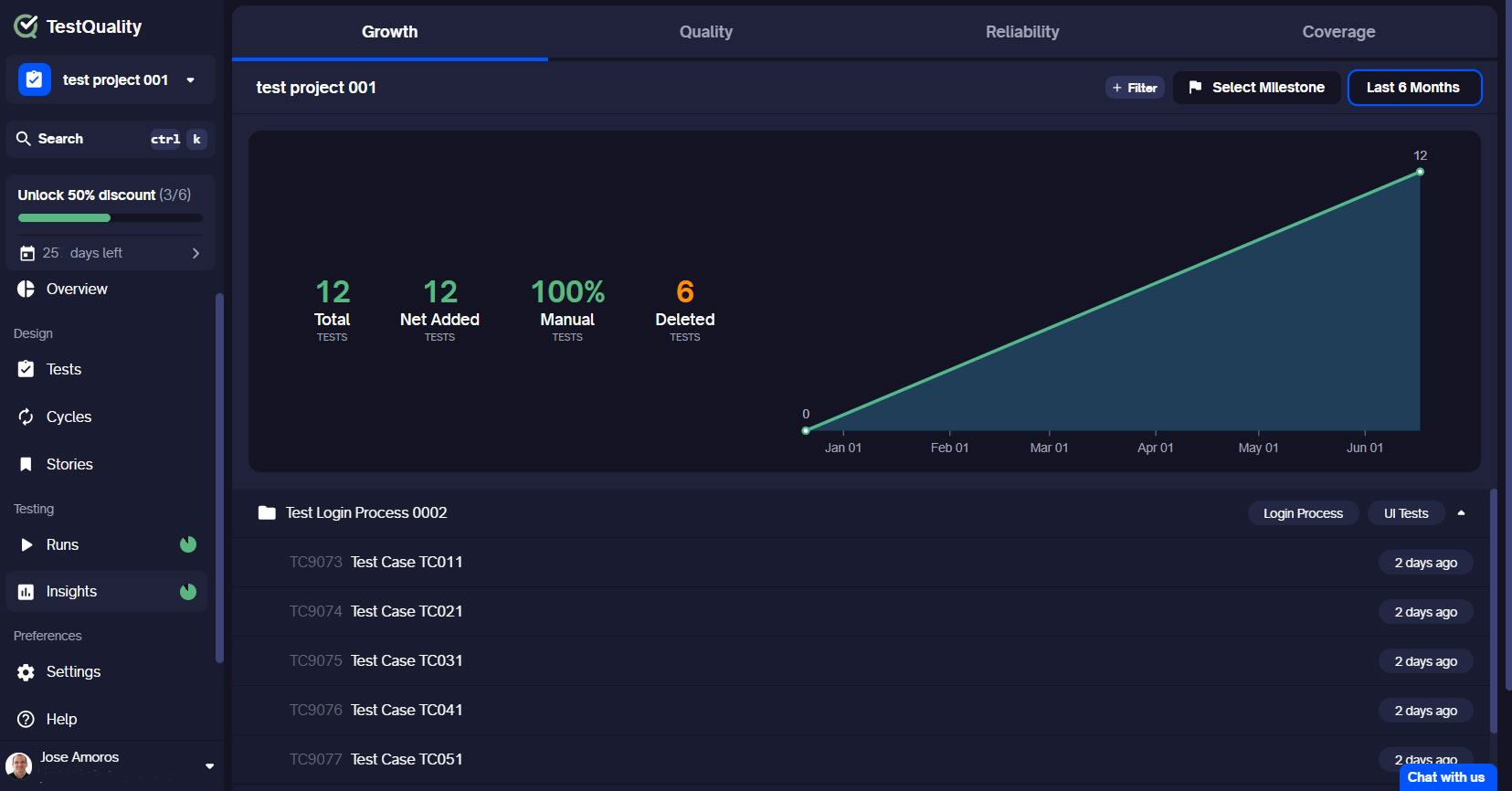In the ever-evolving world of software development, a well-defined test plan is the cornerstone of a successful Quality Assurance (QA) process. For QA professionals, testers, testers, and developers alike, a robust plan ensures comprehensive testing, minimizes risks, and ultimately delivers high-quality software. Traditionally, spreadsheets like Excel have been the go-to tool for crafting test plans. However, as projects grow in complexity, the limitations of spreadsheets become increasingly apparent. This blog post will delve into the significant advantages of utilizing a dedicated Test Management solution like TestQuality.com, empowering you to move beyond the constraints of spreadsheets and build a more efficient, effective testing process.
The Power of a Defined Test Plan
A comprehensive test plan serves as the roadmap for your testing endeavors. It outlines the scope, objectives, resources, and methodologies employed to thoroughly evaluate the software under test. A well-defined plan offers a multitude of benefits:
- Clarity and Consistency: A clear and concise test plan fosters better communication and understanding among all stakeholders, including developers, testers, and project managers. It establishes a consistent testing approach, ensuring all areas are covered effectively.
- Improved Efficiency: A well-organized plan streamlines the testing process. Testers can easily navigate test cases, track progress, and identify areas requiring retesting. This reduces redundancy and optimizes testing efforts.
- Enhanced Risk Management: The test plan allows for the identification of potential risks and defects early in the development cycle. By proactively addressing these risks, you can prevent costly delays and rework later in the process.
- Traceability and Reporting: A robust plan facilitates traceability, allowing you to link test cases to specific requirements. This simplifies reporting and demonstrates the thoroughness of your testing efforts.

Spreadsheets: A Stepping Stone, Not a Destination
While spreadsheets can be a convenient starting point for smaller projects, they quickly become unwieldy as testing requirements grow more intricate. Here's where the limitations of spreadsheets become evident:
Data Management Challenges: Spreadsheets struggle to handle large volumes of test cases, requirements, and defects. Managing complex test data becomes cumbersome, increasing the risk of errors and inconsistencies. Imagine a scenario testing an e-commerce platform with hundreds of product variations and functionalities. A spreadsheet quickly becomes cluttered and difficult to navigate, potentially leading to missed test cases and incomplete testing.
Example: Imagine managing a complex e-commerce platform with hundreds of product variations and functionalities in a spreadsheet. The sheer volume of data would quickly lead to a cluttered and disorganized mess. Test cases might be missed entirely, or inconsistencies could arise due to human error when manually updating a massive spreadsheet.
Limited Collaboration: Spreadsheets are not designed for collaborative environments. Version control issues can arise when multiple testers work on the same document, potentially leading to confusion and wasted effort. For instance, Tester A meticulously crafts test cases for the shopping cart functionality, saving the updated spreadsheet. Unaware of the update, Tester B begins working on the same functionality in a separate version of the spreadsheet. This can lead to duplicated efforts and inconsistencies in the test plan.
- Example: Two testers working on the same functionality in separate versions of a spreadsheet can lead to wasted effort and confusion. Tester A might spend hours crafting test cases for the shopping cart, unaware that Tester B is already working on the same functionality in a different version of the spreadsheet. This duplication of effort can significantly slow down the testing process.
Lack of Automation: Spreadsheets offer minimal automation capabilities, hindering tasks like test case execution and defect reporting. This translates to a more time-consuming and error-prone testing process. Consider a mobile application with numerous user interface elements and interactions. Manually testing each element through a spreadsheet can be tedious and prone to human error. A dedicated Test Management solution can automate repetitive tasks, freeing up tester time for more strategic activities.
- Example: Manually testing a mobile application with hundreds of UI elements through a spreadsheet would be a laborious and error-prone task. A dedicated Test Management solution can automate repetitive tasks like test case execution, freeing up testers to focus on more strategic activities like test design and analysis.
Limited Reporting Features: Effective reporting is crucial for monitoring progress and communicating results. Spreadsheets offer rudimentary reporting capabilities, making it difficult to generate insightful reports that stakeholders can readily understand. Imagine struggling to present clear and concise test coverage data to project managers during sprint reviews. Test Management solutions provide robust reporting features, allowing you to generate visually appealing reports that effectively communicate testing progress and identify areas for improvement.
- Example: Imagine presenting complex test coverage data to stakeholders using a basic spreadsheet chart. The data would likely be difficult to interpret and understand. A dedicated Test Management solution can generate visually appealing reports with interactive dashboards, allowing stakeholders to easily see the progress of testing and identify areas needing attention.
Test Management Solutions: The Next Level
By transitioning from spreadsheets to a dedicated Test Management solution like TestQuality.com, you unlock a treasure trove of benefits that empower you to elevate your testing game. Here's how TestQuality.com empowers you to build a robust testing process:
Centralized Management: TestQuality.com provides a centralized repository for all your testing artifacts – test plans, test cases, requirements, and defects. This fosters improved organization and facilitates easy access for all team members. Imagine a one-stop shop for everything related to your testing efforts. No more hunting through scattered spreadsheets and emails to find the information you need.
- Example: Imagine a team working on a complex web application. With TestQuality.com, all test plans, test cases, requirements, and defect reports are stored in a central location. This allows testers, developers, and project managers to easily access the latest information and collaborate seamlessly.

What is a Run in TestQuality? - Your tests include a number of steps, preconditions, or expected results. The test that you create is designed to be executed by a QA tester, or a test automation system that will go through all of the steps and check that the expected result is a match with the process they have done. This process of executing a test is a test Run.
Enhanced Collaboration: Our platform fosters seamless collaboration among testers. Real-time updates ensure everyone is working on the latest version of test plans and test cases. Communication features like comments and discussions streamline communication and clarification on specific test cases. For instance, Tester A can leave a comment on a specific test case flagging a potential edge case. Tester B can then easily respond and collaborate on refining the test case to ensure comprehensive coverage.
- Example: Two testers working on the login functionality of an application can leverage TestQuality.com's comment and discussion features. Tester A can leave a comment questioning the behavior of the system under a specific scenario. Tester B can then respond with their understanding and suggest modifications to the test case to ensure all aspects of the login functionality are covered.
Streamlined Test Case Management: TestQuality.com empowers you to create, manage, and execute test cases with ease. Design robust test cases with pre-defined steps, expected results, and data sets. Organize test cases into logical test suites for efficient execution. Leverage powerful filtering and searching capabilities to quickly locate specific test cases.
- Example: Imagine testing a new feature in a social media application. With TestQuality.com, you can easily create detailed test cases outlining the steps to create a new post, upload an image, and share it with followers. You can then group these test cases into a "New Post Functionality" test suite for efficient execution. Additionally, filters and search functions allow you to quickly find specific test cases related to image uploading or follower privacy settings.
Automated Testing Capabilities: TestQuality.com integrates seamlessly with popular automation frameworks, allowing you to automate repetitive test cases. This frees up valuable tester time for more strategic activities like exploratory testing and test design. Automated tests can be scheduled for regular execution, ensuring consistent test coverage throughout the development cycle.
- Example: Imagine a web application with a login form that requires testing across different browsers and devices. TestQuality.com's automation capabilities allow you to create automated scripts to test the login functionality across various configurations. This saves testers significant time and effort compared to manually testing each scenario.
Robust Defect Management: TestQuality.com provides a comprehensive defect management system for logging, tracking, and resolving defects. Testers can easily log defects with detailed descriptions, screenshots, and steps to reproduce. Powerful filtering and prioritization features ensure critical defects are addressed promptly. Integration with developer tools allows for streamlined communication and faster defect resolution.
- Example: Imagine a tester discovers a bug where images are not displaying correctly on a product page. With TestQuality.com, they can easily log a defect with a screenshot, detailed description, and steps to reproduce the issue. The system allows for assigning the defect to the appropriate developer and tracking its progress towards resolution.
Advanced Reporting and Analytics: Generate insightful reports that provide a clear picture of your testing progress, test coverage, and defect trends. Visually appealing dashboards with interactive charts and graphs allow stakeholders to easily understand the health of the project. Utilize reporting data to identify areas for improvement and optimize your testing strategy.
- Example: Imagine needing to present testing progress to project managers during a sprint review. TestQuality.com allows you to generate reports that showcase the percentage of test cases executed, the number of defects identified, and the overall test coverage achieved. Interactive charts can visually represent trends and highlight areas requiring further attention.

In conclusion, transitioning from spreadsheets to a dedicated Test Management solution like TestQuality.com represents a significant leap forward for your QA process. TestQuality.com empowers you to streamline workflows, enhance collaboration, and achieve a new level of efficiency and effectiveness in your testing endeavors.
Ready to Experience the Power of TestQuality.com?
Take advantage of our free 14-day trial and discover how TestQuality.com






